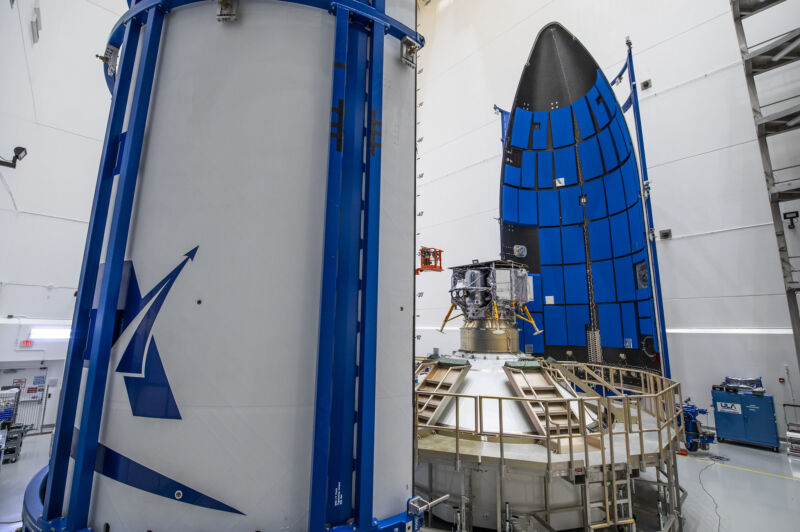Pointing problems —
“We do not expect every launch and landing to be successful.”
Eric Berger – Updated

Enlarge / Astrobotic’s Peregrine lander is seen recently encapsulated inside the Vulcan rocket’s payload fairing.
On Monday morning, the new Vulcan rocket made a smashing debut, launching from Cape Canaveral Space Force Station in Florida and performing flawlessly. After 50 minutes of flight, the rocket’s upper stage deployed its primary payload—the Peregrine lunar lander—into a Moon-bound trajectory. United Launch Alliance declared complete success with its new rocket.
After the deployment of the spacecraft, its developer, Pittsburgh-based Astrobotic, also said its ground controllers had successfully established contact with Peregrine. All seemed well as the spacecraft entered a highly elliptical orbit that will bring it toward the Moon in the coming weeks.
However, later on Monday morning, about six hours after liftoff, Astrobotic released an updated statement. While the vehicle’s avionics systems, including the primary command and data handling unit and the thermal, propulsion, and power controllers, had all powered on and performed as expected, there was a problem.
“After successful propulsion systems activation, Peregrine entered a safe operational state,” the company said. “Unfortunately, an anomaly then occurred, which prevented Astrobotic from achieving a stable sun-pointing orientation. The team is responding in real time as the situation unfolds and will be providing updates as more data is obtained and analyzed.”
Batteries are draining
Less than an hour after its initial statement on the anomaly, Astrobotic issued a second update that sounded fairly ominous.
“We continue to gather data and report our best assessment of what we see,” the company said. “The team believes that the likely cause of the unstable sun-pointing is a propulsion anomaly that, if proven true, threatens the ability of the spacecraft to soft land on the Moon.”
Peregrine will need its main engine to control the spacecraft’s descent down to the lunar surface. Based on additional information provided by the company, it appears that time is running out to fix the problem.
“As the team fights to troubleshoot the issue, the spacecraft battery is reaching operationally low levels,” Astrobotic said. “Just before entering a known period of communication outage, the team developed and executed an improvised maneuver to reorient the solar panels toward the Sun. Shortly after this maneuver, the spacecraft entered an expected period of communication loss.”
According to NASA’s Deep Space Network website, Peregrine reestablished communication with the controllers on Earth by around 11: 30 am ET. The communication then stopped again about 15 minutes later.
Taking shots on goal
If engineers can address the pointing problem and get Peregrine powered back up, there is time to work on the propulsion issue. Due to the spacecraft’s circuitous route to the Moon, Peregrine is not due to land there until February 23.
The spacecraft was privately built and largely funded by NASA through its Commercial Lunar Payload Services Program. The US space agency paid $108 million for the delivery of several science experiments to the Moon, including a radiation sensor, spectrometers, and a laser retroreflector array on board Peregrine. Astrobotic has also sold some payload space to private companies.
With this commercial program, NASA chose to procure a lunar delivery service rather than building a lander on its own. This cost the agency significantly less but entailed more risk. The agency also has funded a lander built by another company, Intuitive Machines, that could launch next month on a Falcon 9 rocket. About 10 more commercial lunar payload missions are in the pipeline.
The former leader of NASA’s scientific programs, Thomas Zurbuchen, has previously said this innovative lunar program was designed with speed in mind and that the agency would tolerate some failures as it takes “shots on goal” in attempting to land on the Moon. “We do not expect every launch and landing to be successful.”
This story has been updated to reflect the issuance of a second statement by Astrobotic.